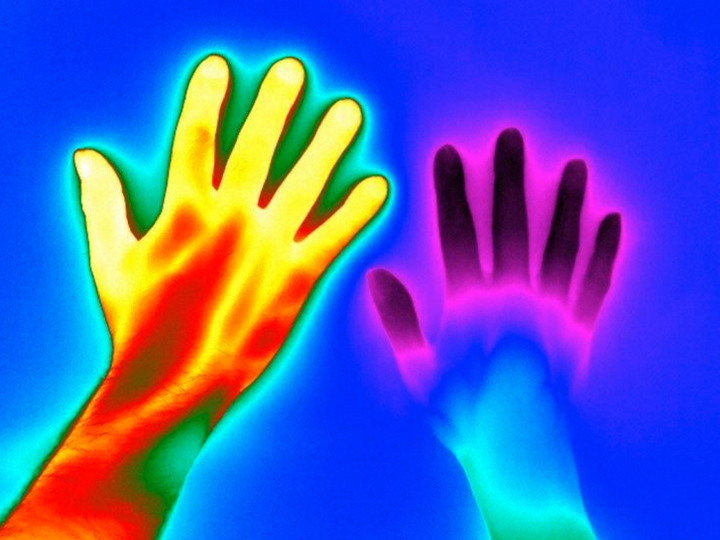Millions of people in the UK could be living with Raynaud’s disease and scleroderma without even knowing it, according to Scleroderma and Raynaud’s UK (SRUK).
Raynaud’s is as common as hay fever or arthritis in the UK, yet over three quarters of people have never heard of it or know nothing about the condition, the health charity said.
Just 4% of people are able to confidently identify the symptoms of Raynaud’s, a figure which falls to 1% when it comes to identifying scleroderma.
If people with Raynaud’s aren’t diagnosed and treated, the condition can potentially lead to a more serious connective tissue disease called scleroderma, which can cause disability and, in some cases, can be life-threatening.

What is Raynaud’s?
In people who have Raynaud’s, the small blood vessels in the extremities are over-sensitive to changes in temperature. This can cause the fingers to sometimes change colour from white, to blue, to red.
A Raynaud’s attack can be a very uncomfortable, possibly painful, process and can make everyday tasks like buttoning a jacket or unzipping a purse difficult.
What are the symptoms of Raynaud’s?
Raynaud’s symptoms generally affect the fingers and toes, but all extremities can be involved including the ears, nose and nipples.
Many of the symptoms of Raynaud’s are relatively common, and often not a sign of anything more serious, which is why many people with the condition go undiagnosed for so long.
The top five symptoms are:
Cold fingers and toes,
Colour changes in the skin in response to cold or stress,
Colour changes in the affected area to white, then blue and then red,
Numbness, tingling or pain in the fingers and toes,
Stinging or throbbing pain upon warming or stress relief.
Symptoms can last from a few minutes to several hours and can be easily triggered by simple things such as grabbing a cold drink from the fridge, holding an ice lolly and cold weather in winter.
The condition is treated with a drug called Nifedipine, a calcium channel blocker. It doesn’t cure it, but it can help relieve symptoms.
There are other drugs and treatment options that can be prescribed commonly for Raynaud’s too, such as botox, acupuncture and, in extreme cases, iloprost - an intravenous drug infusion.

What is scleroderma?
Only a small number of patients with Raynaud’s go on to develop a more serious connective tissue disease called scleroderma. However this condition can cause disability and can even be life-threatening, which is why it’s important to be diagnosed earlier.
Scleroderma is a rare, chronic disease of the immune system, blood vessels and connective tissue.
It is an autoimmune condition, meaning the immune system becomes overactive and attacks healthy tissue in the body.
The name of the condition comes from the Greek, ‘sclero’ for hard, and ‘derma’ for skin. This hardening of the skin can be one of the first noticeable symptoms of the condition, as the body produces too much collagen.
This excess collagen can affect the skin, joints, tendons and internal organs.
It causes scarring and stops the affected parts of the body from functioning normally. The main symptoms are:
Sore, swollen fingers,
Hardening or tightening of the skin in patches,
Raynaud’s symptoms,
Reflux or heartburn.
Anyone experiencing all of the symptoms should visit their GP for a capillaroscopy and blood test to rule out scleroderma.
There are treatments available to help ease the symptoms of scleroderma, but there isn’t a cure.
People living with the condition will usually have several medications to take to manage specific aspects of the condition, for instance fibrosis or pulmonary hypertension.
Treatment options range from disease modifying drugs to intravenous infusions, biological therapies, chemotherapy and in some cases stem cell treatment.
According to research from SRUK, roughly one in five people would be embarrassed to say they lived with the conditions. Meanwhile 20% of people would be frightened to touch someone with Raynaud’s and 24% someone with scleroderma.
Despite a quarter of people saying they had experienced one or more of these most common symptoms repeatedly, only 10% on average have visited their GP about it.
Sue Farrington, chief executive of SRUK, said: “We know that many people do ignore the symptoms and just get on with life, not knowing they have Raynaud’s nor that treatment is available in many cases to help people cope with the painful and sometimes life-changing effects of the condition.
“Beyond a lack of awareness, our research also shows stigma and misunderstanding around Raynaud’s and scleroderma, with many people saying they would be embarrassed to admit they had the conditions, that they would be worried they would pass it on and that they wouldn’t know how to get help or support .
“This needs to change – Raynaud’s can be a minor but uncomfortable inconvenience, but for those more seriously affected by Raynaud’s or Scleroderma, it’s crucial that they seek medical treatment and support as early as possible.”